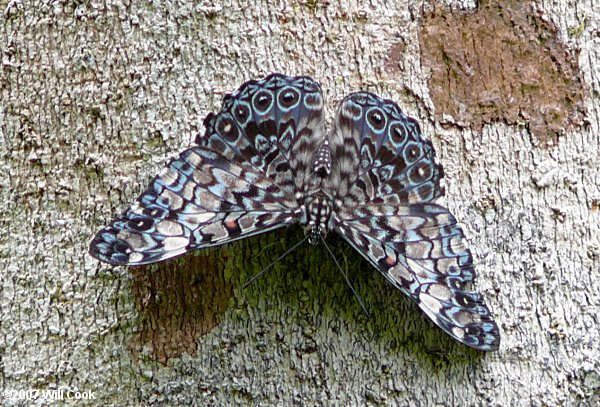
Hamadryas feronia(Hamadryas feronia)
Phylum —arthropoda
Class —insecta
Order — lepidoptera
Family —nymphalidae
Genus –hamadryas
Appearance
The larva has two color morphs; it is either bluish-black above with brownish-white speckles and reddish spots on the side, or it is greyish-green with a pale-colored longitudinal line on the side. It has dorsal spines on the second and third thoracic segments and on the seventh and eighth abdominal segments. The pupa has two long processes on its anterior end.
The wingspan of this butterfly is about 73-83 mm. The upperside of the fore wing is a mosaic pattern of white, brown and bluish-grey, with a row of small eyespots parallel with the outer margin; a small red bar occupies the discal cell. The upside of the hind wing is similar but has few white patches and larger more distinct eyesports. The underside of the fore wing is white or whitish-tan with dark markings, a small red bar and a black submarginal eyespot, and the under hind wing is white or whitish-tan, with dark markings and blue rings containing larger eyespots near the rear margin.
Habitat
It is found in the southern parts of North America and southwards to Brazil.
Behavior
Hamadryas feronia is often seen basking on tree trunks, adopting a head-downward posture with the wings flattened against the bark. Males bask in this position for long periods to await potential mates. They commonly settle at a height of about 2m but if disturbed immediately take flight. After a few seconds they resettle, usually higher up on the same tree trunk. They remain there until the threat passes, after which they descend the trunk in a series of short flights, dropping lower each time until after several minutes they resume their original position.
The butterflies are active from sunrise to sunset, and are rarely seen away from tree trunks, but also sometimes bask on rock faces or tree foliage.
Diet
The larvae feed on vines in the family Euphorbiaceae; in South America, Dalechampia triphylla is often the host plant.
The adult butterflies feed on rotting fruit.
Reproduction
For their reproduction you need a terrarium with a size of 50 x 50 x 70 cm. Females lay eggs one at a time on the leaves of the forage plant. The eggs are white, about 1.2 mm in diameter. Forage plants should be replaced every 3-4 days.It is better to keep the caterpillars in terrariums of 6-8 pieces.In the terrarium, you need to place a branch of a forage plant.The temperature is 23-25 oC at the humidity of65-75 %. Pupae are brown. At the head end there are two flattened, protruding horns in different directions, which look like ears. The butterfly lives for a month and a half.
In captivity
The mesh cage with a size of 50 × 50 × 70 mm is suitable for keeping butterflies. Room temperature is necessary. Daylight time is 12 hours. You can feed the butterflies with an overripe banana or a syrup of honey diluted with boiled water in a ratio of 1:10.
 Russian
Russian
 English
English























